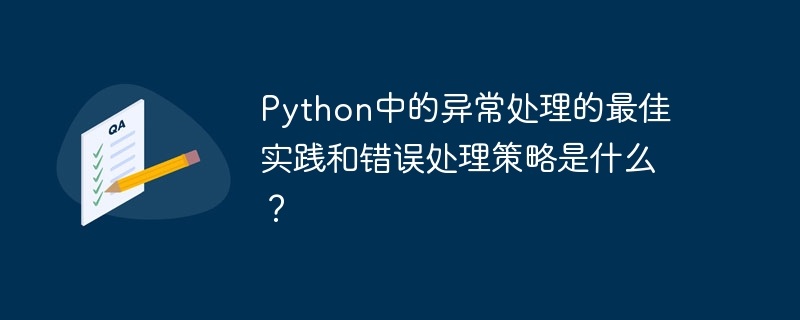Home >Backend Development >Python Tutorial >What are the best practices and error handling strategies for exception handling in Python?
What are the best practices and error handling strategies for exception handling in Python?
- WBOYWBOYWBOYWBOYWBOYWBOYWBOYWBOYWBOYWBOYWBOYWBOYWBOriginal
- 2023-10-19 09:21:381037browse

What are the best practices and error handling strategies for exception handling in Python?
Exception handling is an important programming skill that can help us handle errors in our programs gracefully. In Python, exceptions refer to errors, unexpected or unusual situations that occur during program execution. When an exception occurs, Python will throw an exception object. We can avoid program crashes by catching the exception object and handling it.
Let’s discuss the best practices and error handling strategies for exception handling in Python:
- Use try-except code blocks to catch exceptions
The most common way to handle exceptions is to use try-except code blocks. In the try block, we will include code that may throw an exception, while in the except block, we will handle specific types of exceptions. Using this way, the code does not terminate due to exceptions and we can perform appropriate actions in the except block.
Here is an example:
try:
# 可能引发异常的代码
# ...
except SomeException:
# 处理 SomeException 异常的代码
# ...
except AnotherException:
# 处理 AnotherException 异常的代码
# ...In the above example, we have used two except blocks to handle two different types of exceptions.
- Catch multiple exception types
In addition to catching a single exception type, we can also catch multiple exception types. Doing this helps us perform different actions based on the specific exception type.
Here is an example:
try:
# 可能引发异常的代码
# ...
except (SomeException, AnotherException):
# 处理 SomeException 或 AnotherException 异常的代码
# ...
except Exception as e:
# 处理其他所有异常的代码
# ...In the above example, we have used an except code block to handle SomeException and AnotherException exceptions, and another except code block to handle all other exceptions .
- Catch all exception types
Sometimes, we want to catch all exceptions that may occur. To do this, we can use an except block without specifying any exception type.
Here is an example:
try:
# 可能引发异常的代码
# ...
except:
# 处理所有异常的代码
# ...In the above example, we have omitted the exception type and handled all exceptions in the except block.
- Use finally code block
In addition to using try-except code block to catch exceptions, we can also use finally code block, which will be executed regardless of whether an exception occurs. . Typically, finally blocks are used to release resources or perform cleanup operations.
Here is an example:
try:
# 可能引发异常的代码
# ...
except SomeException:
# 处理 SomeException 异常的代码
# ...
finally:
# 执行无论是否发生异常都要执行的代码
# ...In the above example, the code in the finally code block will be executed regardless of whether an exception occurs.
- Throw a custom exception
Sometimes, we may need to throw a custom exception. To do this, we can create a new exception class that inherits from the Exception class.
Here is an example:
class MyException(Exception):
pass
try:
# 可能引发异常的代码
# ...
raise MyException("发生了自定义异常")
except MyException as e:
# 处理自定义异常的代码
# ...In the above example, we define an exception class called MyException and throw a custom exception in the try code block. In the except block, we can handle this custom exception.
The above are some best practices and error handling strategies for exception handling in Python. By rationally using these methods, we can better handle abnormal situations in the program and optimize the stability and reliability of the program.
(word count: 529)
The above is the detailed content of What are the best practices and error handling strategies for exception handling in Python?. For more information, please follow other related articles on the PHP Chinese website!

